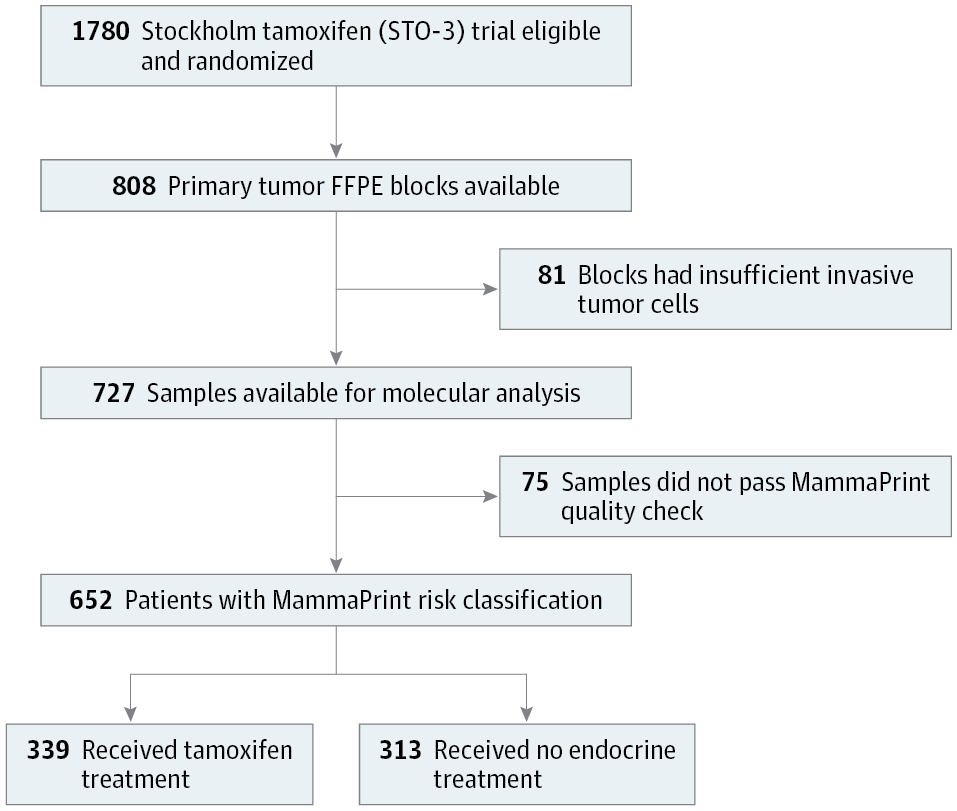JAMA Oncology ( IF 22.5 ) Pub Date : 2017-11-01 , DOI: 10.1001/jamaoncol.2017.1261 Laura J Esserman 1 , Christina Yau 1, 2 , Carlie K Thompson 1 , Laura J van 't Veer 1 , Alexander D Borowsky 3 , Katherine A Hoadley 4 , Nicholas P Tobin 5 , Bo Nordenskjöld 6, 7 , Tommy Fornander 5 , Olle Stål 6, 7 , Christopher C Benz 1, 2 , Linda S Lindström 8

|
Importance The frequency of cancers with indolent behavior has increased with screening. Better tools to identify indolent tumors are needed to avoid overtreatment.
Objective To determine if a multigene classifier is associated with indolent behavior of invasive breast cancers in women followed for 2 decades.
Design, Setting, and Participants This is a secondary analysis of a randomized clinical trial of tamoxifen vs no systemic therapy, with more than 20-year follow-up. An indolent threshold (ultralow risk) of the US Food and Drug Administration–cleared MammaPrint 70-gene expression score was established above which no breast cancer deaths occurred after 15 years in the absence of systemic therapy. Immunohistochemical markers (n = 727 women) and Agilent microarrays, for MammaPrint risk scoring (n = 652 women), were performed from formalin-fixed paraffin-embedded primary tumor blocks. Participants were postmenopausal women with clinically detected node-negative breast cancers treated with mastectomy or lumpectomy and radiation enrolled in the Stockholm tamoxifen (STO-3) trial, 1976 to 1990.
Exposures After 2 years of tamoxifen vs no systemic therapy, regardless of hormone receptor status, patients without relapse who reconsented were further randomized to 3 additional years or none.
Main Outcomes and Measures Breast cancer–specific survival assessed by Kaplan-Meier analyses and multivariate Cox proportional hazard modeling, adjusted for treatment, patient age, year of diagnosis, tumor size, grade, hormone receptors, and ERBB2/HER2 and Ki67 status.
Results In this secondary analysis of node-negative postmenopausal women, conducted in the era before mammography screening, among the 652 women with MammaPrint scoring available (median age, 62.8 years of age), 377 (58%) and 275 (42%) were MammaPrint low and high risk, respectively, while 98 (15%) were ultralow risk. At 20 years, women with 70-gene high and low tumors but not ultralow tumors had a significantly higher risk of disease-specific death compared with ultralow-risk patients by Cox analysis (hazard ratios, 4.73 [95% CI, 1.38-16.22] and 4.54 [95% CI, 1.40-14.80], respectively). There were no deaths in the ultralow-risk tamoxifen-treated arm at 15 years, and these patients had a 20-year disease-specific survival rate of 97%, whereas for untreated patients the survival rate was 94%. Recursive partitioning identified ultralow risk as the most significant predictor of good outcome. In tumors “not ultralow risk,” tumor size greater than 2 cm was the most predictive of outcome.
Conclusions and Relevance The ultralow-risk threshold of the 70-gene MammaPrint assay can identify patients whose long-term systemic risk of death from breast cancer after surgery alone is exceedingly low.
中文翻译:

使用分子工具识别超过 2 年的超低风险惰性乳腺癌患者
重要性 随着筛查的增加,惰性行为的癌症发病率有所增加。需要更好的工具来识别惰性肿瘤以避免过度治疗。
目的 确定多基因分类器是否与随访 2 年的女性浸润性乳腺癌的惰性行为相关。
设计、设置和参与者 这是他莫昔芬与无全身治疗的随机临床试验的二次分析,随访时间超过 20 年。建立了美国食品和药物管理局批准的 MammaPrint 70 基因表达评分的惰性阈值(超低风险),高于该阈值,在没有全身治疗的情况下 15 年后没有发生乳腺癌死亡。用于 MammaPrint 风险评分(n = 652 名女性)的免疫组织化学标记物(n = 727 名女性)和安捷伦微阵列是从福尔马林固定的石蜡包埋的原发性肿瘤块中进行的。参与者是 1976 年至 1990 年参加斯德哥尔摩他莫昔芬 (STO-3) 试验的绝经后妇女,临床检测到淋巴结阴性乳腺癌,接受乳房切除术或乳房肿瘤切除术和放射治疗。
暴露 在他莫昔芬与未全身治疗 2 年后,无论激素受体状态如何,重新同意的无复发患者被进一步随机分配至额外 3 年或不使用。
主要结果和措施 通过 Kaplan-Meier 分析和多变量 Cox 比例风险模型评估乳腺癌特异性生存率,根据治疗、患者年龄、诊断年份、肿瘤大小、分级、激素受体以及ERBB2/HER2和Ki67状态进行调整。
结果 在这项针对淋巴结阴性绝经后妇女的二次分析中,在乳房 X 线摄影筛查之前的时代进行,在 652 名具有 MammaPrint 评分的女性(中位年龄,62.8 岁)中,377 名(58%)和 275 名(42%)是 MammaPrint分别为低风险和高风险,而 98 (15%) 为超低风险。根据 Cox 分析,在 20 年时,与超低风险患者相比,具有 70 基因高和低肿瘤但不是超低肿瘤的女性疾病特异性死亡风险显着更高(风险比,4.73 [95% CI,1.38-16.22]和 4.54 [95% CI, 1.40-14.80])。超低风险他莫昔芬治疗组在 15 年时没有死亡,这些患者的 20 年疾病特异性生存率为 97%,而未经治疗的患者的生存率为 94%。递归分区将超低风险确定为良好结果的最重要预测因素。在“非超低风险”肿瘤中,大于 2 cm 的肿瘤大小是最能预测结果的。
结论和相关性 70 基因 MammaPrint 检测的超低风险阈值可以识别仅手术后乳腺癌长期系统性死亡风险极低的患者。










































 京公网安备 11010802027423号
京公网安备 11010802027423号